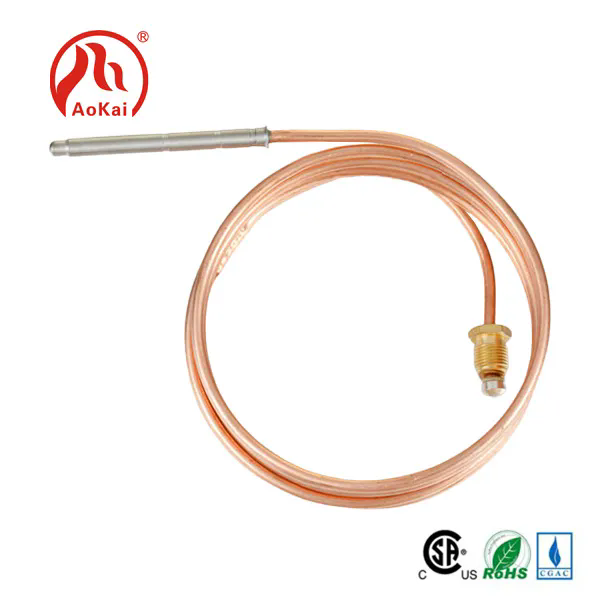Understanding Flexible Thermocouples: A Comprehensive Guide
2024-10-10
In various industries and applications, accurate temperature measurement is critical. Among the devices used for this purpose, flexible thermocouples stand out for their versatility and reliability. In this blog post, we’ll explore what flexible thermocouples are, how they work, their advantages, and where they can be used.
What is a Flexible Thermocouple?
A flexible thermocouple is a type of temperature sensor made from two dissimilar metal wires joined at one end, forming a junction. When this junction is heated or cooled, it generates a voltage that can be correlated to temperature changes. The "flexible" aspect refers to the sensor's design, allowing it to be bent or shaped to fit various applications, making it ideal for measuring temperature in hard-to-reach or irregularly shaped environments.
Key Features of Flexible Thermocouples
1. Versatile Design: Flexible thermocouples can be bent, coiled, or shaped to suit specific measurement needs, making them suitable for a variety of applications.
2. Wide Temperature Range: These sensors can operate effectively across a broad range of temperatures, from cryogenic levels to very high temperatures, depending on the materials used.
3. Fast Response Time: Flexible thermocouples offer quick readings due to their design, which minimizes thermal mass and allows for rapid temperature changes to be detected.
4. Durability: Often constructed with robust materials, flexible thermocouples can withstand harsh environments, making them suitable for industrial applications.
5. Lightweight: Their lightweight nature makes them easy to install and handle, even in tight spaces.
How Flexible Thermocouples Work
Flexible thermocouples operate based on the thermoelectric effect, specifically the Seebeck effect. Here’s a brief overview of how they function:
1. Junction Creation: Two different metal wires (commonly types such as K, J, or T thermocouples) are joined at one end, forming a junction.
2. Temperature Differential: When the junction experiences a temperature change, it generates a small voltage (millivolts) proportional to the temperature difference between the junction and the reference point (typically the connection point to a measuring device).
3. Signal Conversion: This voltage signal is sent to a temperature measuring device (like a digital display or a data acquisition system), which converts it into a readable temperature value.
Advantages of Using Flexible Thermocouples
1. Adaptability to Different Applications
Flexible thermocouples can easily conform to various shapes and surfaces, making them ideal for applications where rigid sensors might not fit. This adaptability is especially useful in environments where space is limited or when measuring temperatures in irregular or moving parts.
2. Quick Temperature Measurements
The rapid response time of flexible thermocouples allows for timely and accurate temperature readings, which is crucial in processes where temperature fluctuations can significantly affect outcomes.
3. Cost-Effective Solution
Compared to other temperature measurement devices, flexible thermocouples are often more affordable and provide reliable performance, making them a popular choice across various industries.
4. Wide Range of Applications
These thermocouples are suitable for a multitude of applications, including:
- Food and Beverage: Monitoring cooking processes and storage temperatures.
- Manufacturing: Ensuring machinery operates within optimal temperature ranges.
- HVAC: Measuring air temperatures in duct systems.
- Automotive: Testing engine and exhaust temperatures.
5. Easy Installation and Maintenance
Their lightweight and flexible design make installation straightforward, and minimal maintenance is required to ensure consistent performance.
Choosing the Right Flexible Thermocouple
When selecting a flexible thermocouple for your application, consider the following factors:
- Temperature Range: Ensure the thermocouple can operate within the temperature limits required for your specific application.
- Material: Choose the appropriate thermocouple type (e.g., K, J, T) based on the environment and temperature range.
- Length and Diameter: Determine the length and diameter needed for the application to ensure proper fitting and functionality.
- Connector Type: Verify compatibility with your measurement system, as different connectors may require specific thermocouple types.
Conclusion
Flexible thermocouples are essential tools for accurate temperature measurement in various industries. Their adaptability, rapid response time, and cost-effectiveness make them a preferred choice for many applications. Whether you’re monitoring temperatures in manufacturing, food processing, or HVAC systems, flexible thermocouples provide reliable and efficient solutions. By understanding their features and benefits, you can make informed decisions and ensure optimal temperature management in your processes. Embrace the flexibility and precision of these thermocouples, and enhance your temperature measurement capabilities today!



